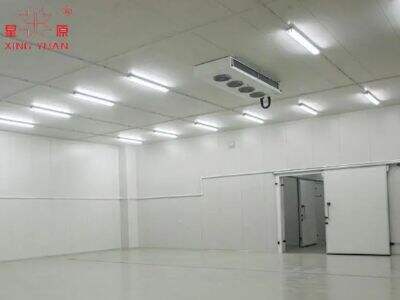चीजों को ठंडा रखने के लिए, विशेष रूप से भोजन और अन्य आवश्यक वस्तुओं के लिए, सही प्रकार का फर्श बहुत ज्यादा महत्वपूर्ण है। ठंडे कमरे का फर्श आम फर्श की तरह नहीं होता, जैसा कि आपको घर या स्कूल में देखने को मिलता है। इसे वास्तव में विशेष कुछ होना चाहिए, ताकि सब कुछ अच्छी तरह से ठंडा बना रहे।
लाभ
तो, शुरुआत करने के लिए, आइए यह समझें कि ठंडे कमरे के वातावरण में इन्सुलेशन और तापमान नियंत्रण क्यों इतने महत्वपूर्ण हैं। इन्सुलेशन ठंडी हवा को अंदर रखता है, गर्म हवा को बाहर। यह ऐसे ही है जैसे आप बहुत ठंड में एक गर्म जैकेट पहन लें - यह परत इन्सुलेशन के रूप में काम करती है ताकि कूल रूम ऊष्मीय रूप से सही तापमान पर रहे और अधिक ऊर्जा का उपयोग न करे। यहाँ विशेषज्ञ इंजीनियरिंग की आवश्यकता होती है।
ठंडे कमरे के फर्श के लिए विशेषज्ञ इंजीनियरिंग की आवश्यकता क्यों है?
विशेषज्ञता युक्त इंजीनियरिंग का तात्पर्य है कि विशेषज्ञ ठंडे कमरे के लिए फर्श को बहुत विशेष तरीके से डिज़ाइन करते हैं। वे देखभाल और रखरखाव पर ध्यान देते हैं, ताकि ठंड कमरे के अंदर बनी रहे या फिर फर्श भारी चीजों को सहने के लिए पर्याप्त मजबूत हो। वे यह भी समझते हैं — या अधिक सटीक रूप से, वे कुछ लोगों की तुलना में तेजी से यह समझ जाते हैं कि यह सुनिश्चित करना बहुत महत्वपूर्ण है कि ठंडा कमरा अत्यधिक ऊर्जा का उपयोग न करे (जिससे बहुत अधिक धन खर्च हो सकता है)।
इसके साथ, आइए ठंडे कमरे में फर्श लगाने की विशिष्ट चुनौतियों पर ध्यान केंद्रित करें। ठंडे कमरे के फर्श बेहद मजबूत होने चाहिए ताकि वे उन पर रखी जाने वाली भारी चीजों को सह सकें। उन्हें ठंड के कारण टूटने या दरारों से भी बचना होता है। यह चुनौतियां हैं, लेकिन फर्श की इंजीनियरिंग के तरीके ऐसे हैं जो मजबूत और विश्वसनीय हैं।
लाभ
विशेषज्ञ इंजीनियरिंग के साथ ठंडे कमरे के फर्श को और अधिक ऊर्जा दक्ष और लागत प्रभावी बनाया जा सकता है। जब ठंडी हवा को अंदर रखने और गर्म हवा को बाहर रखने वाली सामग्री के साथ संयोजित किया जाता है, तो ऊर्जा और अंततः पैसे की बचत होती है। इसका यह भी अर्थ है कि कोल्ड रूम पैनल उचित तापमान पर बनाए रखा जा सकता है बिना बहुत अधिक बिजली की खपत के, जो पर्यावरण के लिए अच्छा है और पैसे के लिहाज से भी अच्छा है।
ड्रेनेज और स्लिप प्रतिरोध अतिरिक्त विचार और विचार हैं जब आप अपने ठंडे कमरे के फर्श की योजना बना रहे होते हैं। ड्रेनेज महत्वपूर्ण है क्योंकि जब पानी फर्श पर फंस जाता है, तो यह सांचा या अन्य गंदी चीजों को उगाने का कारण बन सकता है। स्लिप प्रतिरोध महत्वपूर्ण है क्योंकि ठंडे कमरे भी गीले और फिसलन भरे हो सकते हैं, इसलिए एक ऐसा फर्श होना जो आपको फिसलने-गिरने की दुर्घटना के लिए तैयार कर दे, सुरक्षा के लिए उतना ही महत्वपूर्ण है।
विशेषताएं
जब ठंडे भंडारण सुविधा में उपयोग के लिए सही फर्श का उपयोग नहीं किया जाता है, तो आपको खाद्य नियमों का पालन न करने पर काफी भारी जुर्माने देने पड़ सकते हैं। हमें खाद्य पदार्थों को एक ठंडे कमरे में एक विशिष्ट तापमान पर रखना होता है ताकि वे खाने योग्य बने रहें। यदि फर्श का निर्माण सही ढंग से नहीं किया गया है, तो तापमान में अंतर के कारण खाद्य पदार्थ अलग-अलग दरों पर खराब हो सकते हैं। इससे विभिन्न समस्याएं उत्पन्न हो सकती हैं — जैसे स्वास्थ्य निरीक्षण में असफल होना, या बुरी बात यह है कि लोग बीमार पड़ सकते हैं।
 EN
EN AR
AR BG
BG HR
HR CS
CS DA
DA NL
NL FR
FR DE
DE FI
FI EL
EL HI
HI IT
IT JA
JA KO
KO NO
NO PL
PL PT
PT RO
RO RU
RU ES
ES IW
IW ID
ID LT
LT SR
SR SK
SK LV
LV SL
SL ET
ET IS
IS LA
LA SV
SV UK
UK SQ
SQ GL
GL HU
HU TH
TH AF
AF CY
CY FA
FA
